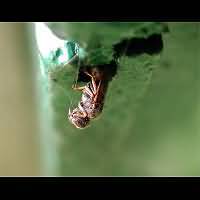Symmorphus crassicornis, a Mason Wasp
Symmorphus crassicornis looks like numerous other wasps: black with yellow stripes and markings. The species of this genus are extremely similar and very hard to tell apart. We have good reasons assuming it is Symmorphus crassicornis depicted on this page. However it remains possible one or both of the animals in the pictures actually belong to another species. In Britain there are some 4 Symmorphus species. Symmorphus crassicornis is the biggest. Females grow to a length of 11 to 16mm, males remain smaller, some 10 to 12mm. Telling the species apart is very difficult, but telling apart the males from the females is very easy, even in the field, for all males have the top of the antenna folded backwards.
Symmorphus crassicornis females are on the wing from May till September. They are always on the look out for good nesting possibilities, or they are hunting for food to deposit with the eggs. Nests are made in cavities in wood, such as the exit holes of beetles. Hollow reet is also used and hand made holes in wood are also gratefully accepted. Contrary to most other Mason Wasps Symmorphus species accept holes running either way, vertically or horizontally. In general a nest exists of three chambers. Each chamber is sealed off with a concrete door. The concrete is made bij the wasp herself by chewing on moist earth. According to a recent study in Lithuania the female collects larvae of just a few species of Leaf Beetles only. Most popular were the Red Poplar Leaf Beetle (Chrysomela populi) and the non British Chrysomela saliceti, a smaller Leaf Beetle species found on poplars as well. Accept for one case all other larvae collected were Chrysomela species too. It is possible though that when these Chrysomela larvae are scarce other larvae are hunted down. The food is stored in the nest cell. An egg is deposited on top of the sedated larvae and then the chamber is sealed off. When the egg hatches, the larvae will eat the fresh food his mother provided him with. No less than three Cuckoo Wasps are parasitic to Symmorphus crassicornis, including the Common Cuckoo Wasp.
Symmorphus crassicornis is quite common in England, common in Wales and rare in Scotland. The status in Ireland is unknown to us.
In the top picture is a male. In the bottom pictures is a female Symmorphus. She lived for a short time only. She tried to crawl out of the hole were she was just born, but didn't succeed. The exit was blocked by a cobweb and she got entangled. As far as we can tell it was a cobweb and not a spider's web, for the animal died untouched and certainly wasn't sucked dry.
Symmorphus crassicornis looks like numerous other wasps: black with yellow stripes and markings. The species of this genus are extremely similar and very hard to tell apart. We have good reasons assuming it is Symmorphus crassicornis depicted on this page. However it remains possible one or both of the animals in the pictures actually belong to another species. In Britain there are some 4 Symmorphus species. Symmorphus crassicornis is the biggest. Females grow to a length of 11 to 16mm, males remain smaller, some 10 to 12mm. Telling the species apart is very difficult, but telling apart the males from the females is very easy, even in the field, for all males have the top of the antenna folded backwards.
Symmorphus crassicornis females are on the wing from May till September. They are always on the look out for good nesting possibilities, or they are hunting for food to deposit with the eggs. Nests are made in cavities in wood, such as the exit holes of beetles. Hollow reet is also used and hand made holes in wood are also gratefully accepted. Contrary to most other Mason Wasps Symmorphus species accept holes running either way, vertically or horizontally. In general a nest exists of three chambers. Each chamber is sealed off with a concrete door. The concrete is made bij the wasp herself by chewing on moist earth. According to a recent study in Lithuania the female collects larvae of just a few species of Leaf Beetles only. Most popular were the Red Poplar Leaf Beetle (Chrysomela populi) and the non British Chrysomela saliceti, a smaller Leaf Beetle species found on poplars as well. Accept for one case all other larvae collected were Chrysomela species too. It is possible though that when these Chrysomela larvae are scarce other larvae are hunted down. The food is stored in the nest cell. An egg is deposited on top of the sedated larvae and then the chamber is sealed off. When the egg hatches, the larvae will eat the fresh food his mother provided him with. No less than three Cuckoo Wasps are parasitic to Symmorphus crassicornis, including the Common Cuckoo Wasp.
Symmorphus crassicornis is quite common in England, common in Wales and rare in Scotland. The status in Ireland is unknown to us.
In the top picture is a male. In the bottom pictures is a female Symmorphus. She lived for a short time only. She tried to crawl out of the hole were she was just born, but didn't succeed. The exit was blocked by a cobweb and she got entangled. As far as we can tell it was a cobweb and not a spider's web, for the animal died untouched and certainly wasn't sucked dry.






